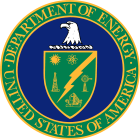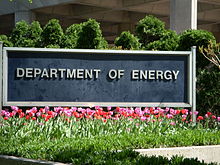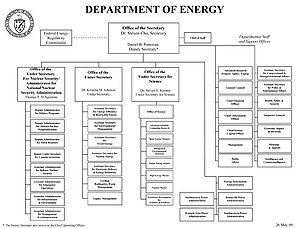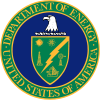- United States Department of Energy
-
United States
Department of Energy
Seal of the Department of Energy 
James Forrestal headquarters complex in Washington, D.C. Department overview Formed August 4, 1977 Preceding agencies Energy Research and Development Administration
Federal Energy AdministrationEmployees 16,000 federal (2009)[1]
93,094 contract (2008)Annual budget $24.1 billion (2009) Department executives Dr. Steven Chu, Secretary
Daniel Poneman, Deputy Secretary.Website energy.gov The United States Department of Energy (DOE) is a Cabinet-level department of the United States government concerned with the United States' policies regarding energy and safety in handling nuclear material. Its responsibilities include the nation's nuclear weapons program, nuclear reactor production for the United States Navy, energy conservation, energy-related research, radioactive waste disposal, and domestic energy production. DOE also sponsors more basic and applied scientific research than any other US federal agency; most of this is funded through its system of United States Department of Energy National Laboratories.
The agency is administered by the United States Secretary of Energy, and its headquarters are located in southwest Washington, D.C., on Independence Avenue in the Forrestal Building, named for James Forrestal, as well as in Germantown, Maryland.
Contents
History
In 1942, during World War II, the United States started the Manhattan Project, a project to develop the atomic bomb, under the eye of the U.S. Army Corps of Engineers. After the war, the Atomic Energy Commission was created to control the future of the project.
The AEC was reinstated and gave way to Nuclear Regulatory Commission, which was tasked with regulating the nuclear power industry, and the Energy Research and Development Administration, which was tasked to manage the nuclear weapon, naval reactor, and energy development programs.
The 1973 oil crisis called attention to the need to consolidate energy policy. On August 4, 1977, President Jimmy Carter signed into law The Department of Energy Organization Act of 1977 (P.L. 95-91, 91 Stat. 565), which created the Department of Energy.[2] The new agency, which began operations on October 1, 1977, assumed the responsibilities of the Federal Energy Administration, the Energy Research and Development Administration, the Federal Power Commission, and programs of various other agencies.
Organization
 Sign in front of the United States Department of Energy Forrestal Building on Independence Avenue in Washington D.C.
Sign in front of the United States Department of Energy Forrestal Building on Independence Avenue in Washington D.C.
The Department is under the control and supervision of a United States Secretary of Energy, a political appointee of the President of the United States. The Energy Secretary is assisted in managing the Department by a United States Deputy Secretary of Energy, also appointed by the President, who assumes the duties of the Secretary in his absence. The Department also has three Under Secretaries of Energy, each appointed by the President, who oversee the major areas of the Department's work. To aid the Under Secretaries in the performance of their duties, the President also appoints eight Assistant Secretaries of Energy. The Energy Secretary assigns their functions and duties.
- Secretary of Energy
- Deputy Secretary
- Under Secretary of Energy for Energy and Environment
- Office of Civilian Radioactive Waste Management
- Office of Electricity Delivery and Energy Reliability
- Office of Energy Efficiency and Renewable Energy
- Office of Environmental Management
- Office of Fossil Energy
- Office of Legacy Management
- Office of Nuclear Energy, Science & Technology
- Under Secretary of Energy for Science
- Under Secretary of Energy for Nuclear Security
- Office of Intelligence and Counterintelligence
- Energy Information Administration
- Bonneville Power Administration
- Southeastern Power Administration
- Southwestern Power Administration
- Western Area Power Administration
- Under Secretary of Energy for Energy and Environment
- Federal Energy Regulatory Commission
- Deputy Secretary
Facilities
As the lead energy research and development agency in the United States, the Department of Energy operates a number of science laboratories. They are as follows:
- Albany Research Center
- Ames Laboratory
- Argonne National Laboratory
- Bannister Federal Complex
- Bettis Atomic Power Laboratory - focuses on the design and development of nuclear power for the U.S. Navy.
- Brookhaven National Laboratory
- Center for Functional Nanomaterials (under design or construction)
- Center for Integrated Nanotechnologies (under design or construction)
- Center for Nanophase Materials Sciences
- Center for Nanoscale Materials (under design or construction)
- Environmental Measurements Laboratory (now affiliated with the Department of Homeland Security)
- Fermi National Accelerator Laboratory
- Idaho National Laboratory
- Kansas City Plant
- Knolls Atomic Power Laboratory - operates for Naval Reactors Program Research under the DOE - DOE facility, not a National Laboratory
- Lawrence Berkeley National Laboratory
- Lawrence Livermore National Laboratory
- Los Alamos National Laboratory
- National Energy Technology Laboratory
- National Petroleum Technology Office
- Nevada Test Site
- New Brunswick Laboratory
- Oak Ridge National Laboratory
- Office of Fossil Energy[1]
- Office of River Protection[2] (Hanford Site)
- Pacific Northwest National Laboratory
- Pantex
- Radiological and Environmental Sciences Laboratory
- Sandia National Laboratories
- Savannah River National Laboratory
- SLAC National Accelerator Laboratory
- Thomas Jefferson National Accelerator Facility
- Y-12 National Security Complex
- Yucca Mountain nuclear waste repository
Responsibility for nuclear weapons
In the United States, all nuclear weapons deployed by the United States Department of Defense (DoD) are actually on loan to DoD from the DOE/NNSA,[3] which has federal responsibility for the design, testing and production of all nuclear weapons. NNSA in turn uses contractors to carry out its responsibilities at the following government owned sites:
- Design of the nuclear components of the weapon: Los Alamos National Laboratory and Lawrence Livermore National Laboratory
- Engineering of the weapon systems: Sandia National Laboratories
- Manufacturing of key components: Los Alamos National Laboratory, the Kansas City Plant, and Y-12 National Security Complex
- Testing: Nevada Test Site
- Final weapon/warhead assembling/dismantling: Pantex
Controversy
During the Wen Ho Lee scandal, involving stolen nuclear secrets from Los Alamos National Laboratory, hearings were called in Congress regarding the Department of Energy's handling of the matter. Republican senators thought that an independent agency should be in charge of nuclear weapons and security issues, not the Department of Energy.[4] Federal officials, including then-Energy Secretary Bill Richardson, had publicly named Lee as a suspect in the theft of classified nuclear documents before he was charged with a crime; he was later cleared of the spying charges and won a settlement with the federal government.[5]
Related legislation
- 1920 - Federal Power Act
- 1946 - Atomic Energy Act PL 79-585 (created the Atomic Energy Commission)
- 1954 - Atomic Energy Act Amendments PL 83-703
- 1956 - Colorado River Storage Project PL 84-485
- 1957 - Atomic Energy Commission Acquisition of Property PL 85-162
- 1957 - Price-Anderson Nuclear Industries Indemnity Act PL 85-256
- 1968 - Natural Gas Pipeline Safety Act PL 90-481
- 1973 - Mineral Leasing Act Amendments (Trans-Alaska Oil Pipeline Authorization) PL 93-153
- 1974 - Energy Reorganization Act PL 93-438 (Split the AEC into the Energy Research and Development Administration and the Nuclear Regulatory Commission)
- 1975 - Energy Policy and Conservation Act PL 94-163
- 1977 - Department of Energy Organization Act PL 95-91 (Dismantled ERDA and replaced it with the Department of Energy)
- 1978 - National Energy Act PL 95-617, 618, 619, 620, 621
- 1980 - Energy Security Act PL 96-294
- 1989 - Natural Gas Wellhead Decontrol Act PL 101-60
- 1992 - Energy Policy Act of 1992 PL 102-486
- 2005 - Energy Policy Act of 2005 PL 109-58
- 2007 - Energy Independence and Security Act of 2007 PL 110-140
- 2008 - Food, Conservation, and Energy Act of 2008 PL 110-234
Budget
President Barack Obama unveiled on May 7 a $26.4 billion budget request for DOE for fiscal year (FY) 2010, including $2.3 billion for the DOE Office of Energy Efficiency and Renewable Energy (EERE). The budget aims to substantially expand the use of renewable energy sources while improving energy transmission infrastructure. It also makes significant investments in hybrids and plug-in hybrids, in smart grid technologies, and in scientific research and innovation.[6]
As part of the $789 billion economic stimulus package in the American Recovery and Reinvestment Act of 2009, Congress provided Energy with an additional $38.3 billion for fiscal years 2009 and 2010, adding about 75 percent to Energy's annual budgets. Most of the stimulus spending was in the form of grants and contracts. Yet, according to Robert Alvarez, "Even with additional stimulus money, spending for bombs and cleanup will still exceed those for actual energy-related functions. Spending for the weapons complex is currently comparable to that during the height of the nuclear arms race in the 1950s. The big difference now — half of that money is spent dealing with the Cold War's environmental legacy.[7] "
For fiscal year 2011, each of the operating units of the Department of Energy operate with the following budgets:[8]
Division Funding (in billions) Management $0.4 Energy and Environment $10.6 Science $4.9 Nuclear Security $10.5 Other $0.6 Total $27 Energy Savings Performance Contract
Main article: Energy Savings Performance ContractEnergy Savings Performance Contracts (ESPCs) are contracts under which a contractor designs, constructs, and obtains the necessary financing for an energy savings project, and the federal agency makes payments over time to the contractor from the savings in the agency's utility bills. The contractor guarantees the energy improvements will generate savings, and after the contract ends, all continuing cost savings accrue to the federal agency.[9]
= Loan Guarantee Program = {Main|Loan guarantee}
Title XVII of Energy Policy Act of 2005 authorizes the U.S. Department of Energy to issue loan guarantees to eligible projects that "avoid, reduce, or sequester air pollutants or anthropogenic emissions of greenhouse gases" and "employ new or significantly improved technologies as compared to technologies in service in the United States at the time the guarantee is issued".[10]
In loan guarantees, a conditional commitment requires to meet an equity commitment, as well as other conditions, before the loan guarantee is closed.[11]
Energy Innovation Hubs
Energy Innovation Hubs are multi-disciplinary meant to advance highly promising areas of energy science and technology from their early stages of research to the point that the risk level will be low enough for industry to commercialize the technologies.[6]
The DOE budget includes $280 million to fund eight Energy Innovation Hubs, each of which is focused on a particular energy challenge. Two of the eight hubs are included in the EERE budget and will focus on integrating smart materials, designs, and systems into buildings to better conserve energy and on designing and discovering new concepts and materials needed to convert solar energy into electricity. Another two hubs, included in the DOE Office of Science budget, will tackle the challenges of devising advanced methods of energy storage and creating fuels directly from sunlight without the use of plants or microbes. Yet another hub will develop "smart" materials that will allow the electrical grid to adapt and respond to changing conditions.[6]
Past Secretaries of Energy
Term Name President served August 6, 1977 - August 23, 1979 James R. Schlesinger Jimmy Carter August 24, 1979 - January 20, 1981 Charles W. Duncan, Jr. Jimmy Carter January 23, 1981 - November 5, 1982 James B. Edwards Ronald Reagan November 5, 1982 - February 7, 1985 Donald Paul Hodel Ronald Reagan February 7, 1985 - January 20, 1989 John S. Herrington Ronald Reagan March 1, 1989 - January 20, 1993 James D. Watkins George H.W. Bush January 22, 1993 - January 20, 1997 Hazel R. O'Leary Bill Clinton March 12, 1997 - June 30, 1998 Federico F. Peña Bill Clinton August 18, 1998 - January 20, 2001 Bill Richardson Bill Clinton January 20, 2001 - January 31, 2005 Spencer Abraham George W. Bush February 1, 2005 - January 20, 2009 - Samuel W. Bodman George W. Bush January 21, 2009 - Current Steven Chu Barack Obama See also
- 2010 United States federal budget
- Advanced Energy Initiative
- American Recovery and Reinvestment Act of 2009
- Appropriation (law)
- ARPA-E
- Energy Policy Act of 2005
- Federal Energy Management Program
- Fernald Feed Materials Production Center
- Funding Opportunity Announcement
- GovEnergy
- Green job
- Human experimentation in the United States
- Institute of Nuclear Materials Management
- Loan guarantee
- National Council on Electricity Policy
- North American Solar Challenge
- Nuclear Regulatory Commission
- Protective Action Guide for Nuclear Incidents
- Radioactive waste
- Recovery Act
- Smart grid
- Solar Decathlon
- State Energy Program
- Twenty In Ten
- The World Institute for Nuclear Security
- Weatherization Assistance Program
References
- ^ http://www.cfo.doe.gov/CF1-2/2008CR.pdf
- ^ Relyea, Harold; Thomas P. Carr (2003). The executive branch, creation and reorganization. Nova Publishers. pp. 29.
- ^ Chomsky, Noam (1993-02). "The Pentagon System". Z Magazine. http://www.thirdworldtraveler.com/Chomsky/PentagonSystem_Chom.html. Retrieved 2009-03-14.
- ^ Plotz, David (June 23, 2000). "Energy Secretary Bill Richardson". Slate.com. http://www.slate.com/id/84864/. Retrieved 2008-11-07.
- ^ Mears, Bill (May 22, 2006). "Deal in Wen Ho Lee case may be imminent". CNN. http://www.cnn.com/2006/LAW/05/22/scotus.wenholee/. Retrieved 2008-11-07.
- ^ a b c "EERE News: DOE Requests $2.3 Billion for Efficiency, Renewable Energy in FY 2010". Apps1.eere.energy.gov. 2009-05-13. http://apps1.eere.energy.gov/news/news_detail.cfm/news_id=12509. Retrieved 2009-08-25.
- ^ Is the Energy Department Ready to Reboot the Country?, Institute for Policy Studies, March 27, 2009
- ^ Department of Energy FY2012 Budget Request, Department of Energy - Office of the Chief Finanicial Officer, February 2012
- ^ "EERE News: DOE Awards 16 Contracts for Energy Savings at Federal Facilities". Apps1.eere.energy.gov. 2009-01-07. http://apps1.eere.energy.gov/news/news_detail.cfm/news_id=12163. Retrieved 2009-08-25.
- ^ "Department of Energy - Loan Guarantee Program". Lgprogram.energy.gov. 2006-12-31. http://www.lgprogram.energy.gov/features.html. Retrieved 2009-08-25.[dead link]
- ^ "EERE News: DOE Offers $535 Million Loan Guarantee to Solyndra, Inc". Apps1.eere.energy.gov. 2009-03-20. http://apps1.eere.energy.gov/news/news_detail.cfm/news_id=12360. Retrieved 2009-08-25.
External links
- "United States Department of Energy Official Website". http://www.energy.gov/. Retrieved August 7, 2006.
- "Energy Information Administration". Department of Energy. http://www.eia.doe.gov/. Retrieved August 7, 2006.
- Proposed and final federal regulations from the Department of Energy
- Loan Guarantee Program
- "Office of Science". Department of Energy. http://www.energy.gov/about/index.htm. Retrieved August 7, 2006.
- Works by the United States Department of Energy at Project Gutenberg
- Advanced Energy Initiative
- Twenty In Ten.
- Office of Electricity Delivery and Energy Reliability
- Proposed and finalized federal regulations from the United States Department of Energy
- GovEnergy
- United States Department of Energy at WhoRunsGov at The Washington Post
Energy in the United States Politics and law Energy Lobby · Energy policy · Energy Policy Act (1992 · 2005) · Offshore drilling debate · Oil politics · RPS · Secretary of Energy · New Energy For America · Energy law of the United StatesSources Material Solar by state Arizona · California · Hawaii · Nevada · New Jersey · New Mexico · OregonWind by state Environmental issues Organizations United States federal executive departments Agriculture • Commerce • Defense • Education • Energy • Health and Human Services • Homeland Security • Housing and Urban Development • Interior • Justice • Labor • State • Transportation • Treasury • Veterans Affairs
Categories:- Nuclear weapons infrastructure of the United States
- Energy in the United States
- United States Department of Energy
- Ministries established in 1977
- Secretary of Energy
Wikimedia Foundation. 2010.


